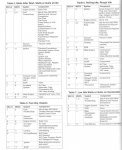yo TOM,
Try a Self Test for Diagnostic Trouble Codes (DTC)s by my pal, BroncoJoe19
http://broncozone.com/topic/14269-code-reader/page__pid__74587__mode__threaded
The engine temperature must be greater than 50° F for the Key On Engine Off (KOEO) Self-Test and greater than 180° F for the Key On Engine Running (KOER) Self-Test.
Run it around to heat the engine up and shift thru all gears incl Reverse. Then turn off all accessories/lights, etc.
Make sure A/C is off and transmission is in Park (automatic) or in Neutral for a Manual & release clutch.
Do Key On Engine Off (KOEO) portion first.
Look Codes up in my broncolinks.com site using the new Search function.
And Post em here according to:
KOEO
&
KOER
Here are the possible causes

If no codes in KOEO or KOER, check for vacuum leaks
Vacuum Leak Test; On an idling engine check for vacuum leaks using a mechanic's stethoscope with the probe removed, or a ~3' garden hose section. BEWARE of fab, belts, pulleys and hot engine/hoses.
On COLD ENGINE only, use propane torch w/rubber hose attached, UNLIT (have fire ext @ hand for all tests)
or spray carb cleaner, when it gets to the the leak the RPMs will rise.
Also check: vacuum hoses; intake manifold gasket & throttle body and lower intake;
intake manifold gasket & throttle body (Worn throttle shaft) and lower intake; & vac tree
Vacuum Tree Location pic in a 94

by joelb23
PCV damaged or vac line leak
- pic by Bbronco311

Air Diverter Valve (AIRD) from TAD Solenoid & Air Bypass Valve (AIR BPV) from TAB Solenoid or a Air Bypass Valve (AIR BPV) & Air Diverter Valve (AIRD) Combination located behind the intake manifold

vacuum reservoirs:
EGR Sys Vacuum Tank & 2ndry air (VRESER - looks like a coffee can in earlier years & often rusts out causing vac leaks; but later years (at least 92-96, may have the plastic type reservoir);
Depiction & Location in Parts Break-Out Diagram in a 96 w/Ford part numbers
Source: by Ford via miesk5 at
http://www.broncolinks.com/gallery_images/96TABTAB5.0.jpg
Thermactor Air Bypass Solenoid (TAB, AIRB, AM1) w/Pink vacuum line & Air Bypass Valve (AIR BPV) & Thermactor Air Diverter Solenoid (TAD, AIRD, AM2) w/Yellow vacuum line & Air Diverter Valve or Air Control Valve (ACV) see my site @
http://www.broncolinks.com/index.php?index=416 & EGR Vacuum Regulator (EVR); also called EGR Vacuum Solenoid & EGR Valve Position (EVP) - MIESK5 NOTE: EVP is used on all years except for 95 5.8L California models & all 96, they use the DPFE Sensor instead of EGR Valve Position Sensor (EVP) etc,
Check vacuum hose; & valves for damage
AC, heater, defroster, vent control ckt & vacuum tank (plastic ball, or an irregular box glued to the evaporator cover), under dash & lines to heat/blend/etc. doors; & HVAC vacuum reservoir;Check Valve & Tank Location pic in a 93; "...valve is about a foot down the vacuum line coming off the 'tree' on the engine Plenum. One of the lines on the check valve tee goes to the built-in reservoir on the a/c box, the other into the loom with the white tube heading for the control panel inside ..."

Carbon Canister (Charcoal Canister, Vapor Canister, Evaporative Emission (EVAP) Canister for the Evaporative System (see
http://info.rockauto.com/Motorcraft/CX1118.jpg)
Fuel Pressure Regulator (FPR): check vacuum line...pics in a 94
by 1994xlt (Cole R) at
http://www.supermotors.net/registry/5978/20463
and line to & Cruise Control sys in 86-91
leaky O-rings around the fuel injectors are allowing air to leak past the seals.
& Line to & the power brake booster and booster itself
Vacuum Gauge Diagnosis
"...The vacuum gauge should show 18-22 in-Hg @ idle, and maintain a steady needle. Rev it up to ~2500 rpm, hold it steady, and you should see the needle drop, then slowly increase to a level close to the idle reading (though slightly lower is normal)..."
Source: by SigEpBlue (Steve)
http://www.classictruckshop.com/clubs/earlyburbs/projects/vac/uum.htm
The vacuum gauge should show around 18-22 in-Hg @ idle & maintain a steady needle. Rev it up to ~2500 rpm, hold it steady, and you should see the needle drop, then slowly increase to a level close to the idle reading (though slightly lower is normal). by CRAIG
Suggest buying a vac gauge, best low cost test and MPG helper you can spend $ on;
pic; "...I have a vacuum gauge mounted right in the dash of my truck. I use it to also help determine the load my engine is under while driving, and to estimate fuel economy..."
Source: by William T at
http://www.fordf150.net/images/mytruck/vacgauge.jpg







